Last updated on
Exploring pizzelle press cast iron ideas is crucial because it elevates your dessert-making experience by delivering deliciously crisp, thin, and intricate waffle-like cookies typical in Italian culture.
These are my unique design concepts made using design tools. I hope you find them inspiring!
Discover a world of delicious possibilities with a well-worn cast iron pizzelle press. Everyone knows its traditional use for creating intricate, wafer-thin Italian cookies, but this article dives further into the uses of this versatile kitchen tool.
Ever wonder about inventive ways to use your pizzelle press? This article is here to inspire with fresh, unique ideas and new angles, from crafting edible bowls to whipping up an impromptu panini.
While traditional ideas lie in abundance, the goal is to offer novel uses to ignite your culinary imagination. By the end of the article, we’ll link resources that expound on the best existing ideas, to enhance your pizzelle press experience.
Let’s unravel these striking innovations together.
What's Inside
Historic Origins of the Pizzelle Press

Originating from Italy, pizzelle presses have a rich history that dates back to the 8th century. They gained popularity across the region due to their versatility and durability. Early designs featured beautiful patterns inspired by nature and local customs. These designs etched into the faces of the press add an aesthetically pleasing touch to the cookies, turning each one into a work of art.
Craftsmen initially made these presses entirely of cast iron due to the material’s excellent heat retention and distribution features. People kept their presses heated over open fires before placing the batter on the surface and pressing it into shape. As a sign of prestige and wealth, families would often have their family crests carved into the press.
Despite the modern advancements in kitchen arrangements and practices, the essential operation of pizzelle presses remains largely unchanged. It is a testament to the effectiveness and timeless design of this beloved baking tool in not just Italian, but global culinary traditions.
How to Maintain Your Cast Iron Pizzelle Press

Preserving the quality of this kitchen essential entails a simple routine after each use. Start by allowing the press to cool completely. Use a cloth or a soft-bristle brush to remove any food particles, taking care not to scour or scrub as this could damage the seasoning. Remember, soap or harsh detergents are a no-no for cast iron, as they can strip away the protective patina.
From time to time, it will be necessary to re-season your press. This process involves coating the iron surface with cooking oil and heating it in a hot oven. Regular re-seasoning helps maintain its non-stick capabilities and prevents rusting.
When storing your press, keep in a dry place to avoid moisture build-up, which can lead to rust. It’s also beneficial to put a sheet of paper towel inside the plates of the press to absorb any residual moisture.
Remember, the charm of a cast-iron pizzelle press is in its long-lasting durability, which can be ensured with these care steps.
The Difference Between Non-Stick and Cast Iron Pizzelle Presses
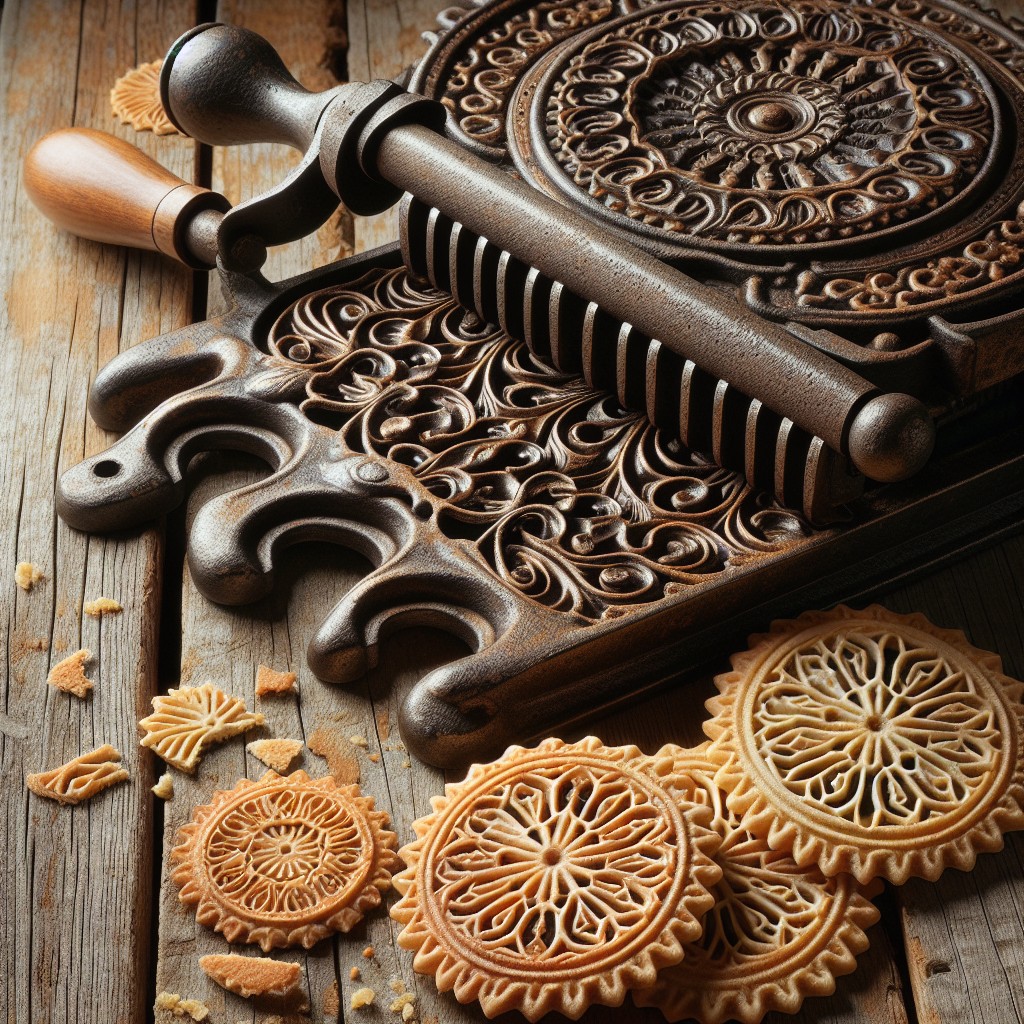
Both types boast their unique advantages. The non-stick variety, often lighter, is known for its easy-release feature and minimal cleaning effort. However, over time, the non-stick layer can peel or scratch, possibly contaminating your pizzelles.
In contrast, cast iron presses are perceptibly heavy-duty and durable. With proper care, these can last for generations, developing a natural non-stick layer or “seasoning” over time. They deliver evenly distributed heat, promising a perfectly cooked pizzelle every time.
However, the cast iron press does require careful maintenance. Without it, your press is at risk of rusting. But worry not, an initial seasoning and regular oiling should keep it fit as a fiddle. Also, hand-washing is recommended over using a dishwasher.
It’s worth mentioning that a well-seasoned cast iron pizzelle press has an added bonus of imparting a richer flavor, adding an extra dimension to your traditional cookie.
Choosing between non-stick or cast iron ultimately comes to personal preference, lifestyle, and how much effort you want to put into maintenance and use.
Top 10 Recipes To Try With Your Pizzelle Press

1. Classic Anise: A traditional favorite, this recipe utilizes anise seeds and extract for a delightful licorice flavor.
2. Cinnamon Sugar: Add generous amounts of cinnamon and sugar to your batter for a delicious dessert pizzelle.
3. Chocolate Hazelnut: Mix in some melted dark chocolate and hazelnut extract for a truly decadent treat.
4. Lemon Zest: A tangy option, combining fresh lemon zest and juice with your standard dough mixture.
5. Almond Joy: Incorporate sweetened coconut flakes and crushed almond pieces into the batter for a tropical touch.
6. Coffee Cardamom: Create a sophisticated pizzelle by blending finely ground coffee and cardamom spice into the dough.
7. Maple Walnut: A Canadian favorite, using real maple syrup and crushed walnuts in the batter.
8. Pumpkin Spice: Take your favorite fall flavors of nutmeg, cinnamon, ginger, and cloves, and mix them with canned pumpkin for a festive option.
9. Matcha Green Tea: For the adventurous palate, whisk matcha powder into your standard batter for a uniquely vibrant and exotic treat.
10. Gluten-Free Vanilla: Substitute regular flour with a gluten-free option and add real vanilla extract– a perfect recipe for those with dietary restrictions.
Pizzelle Press: Cast Iron Vs Aluminum

Reflecting on their key characteristics, both materials have distinct advantages.
Firstly, cast iron excels in heat retention and uniform distribution, making it ideal for creating evenly-cooked, crispy pizzelles. It’s sturdy and long-lasting, so it can become a cherished kitchen heirloom. However, it’s also heavier, which can be a downside for some users.
On the contrary, an aluminum press is much lighter in weight, more affordable, and heats up swiftly. However, the trade-off for this speed and weight is typically a lower lifespan, as aluminum isn’t as durable as cast iron.
Lastly, in terms of maintenance, cast iron requires careful handling; proper seasoning, use, and cleaning can extend its lifespan. In contrast, aluminum is low-maintenance but may require more frequent replacements.
Unique Pizzelle Flavors to Create With Your Press

Put aside the traditional anise and vanilla, and let’s explore some out-of-the-box combinations!
1. Lemon and Poppy Seed: Add fresh lemon zest and poppy seeds to your batter for a bright, pleasant twist.
2. Matcha and White Chocolate: Incorporate 1-2 teaspoons of matcha powder and garnish with melted white chocolate for a sweet and earthy combination.
3. Orange and Clove: Citrus and spice unite! Use fresh orange zest and ground cloves for a warm, aromatic delight.
4. Coconut and Lime: A tropical treat! Add shredded coconut and lime zest into your batter for an island-inspired dessert.
5. Cinnamon and Apple: Blend grated fresh apple and cinnamon into your pizzelle pastry for a flavor reminiscent of apple pie.
6. Chocolate and Chili: For the adventurous palate. Add a scoop of cocoa powder and a sprinkle of chili flakes for a rich flavor with a kick.
Remember to balance the flavor ratios to avoid a taste that’s too overpowering. Soon you’ll be inventing your own unique flavor pairings! Embark on your culinary adventure and impress your guests with these novel pizzelle variations. Happy cooking!
Best Cleaning Techniques for Cast Iron Pizzelle Press
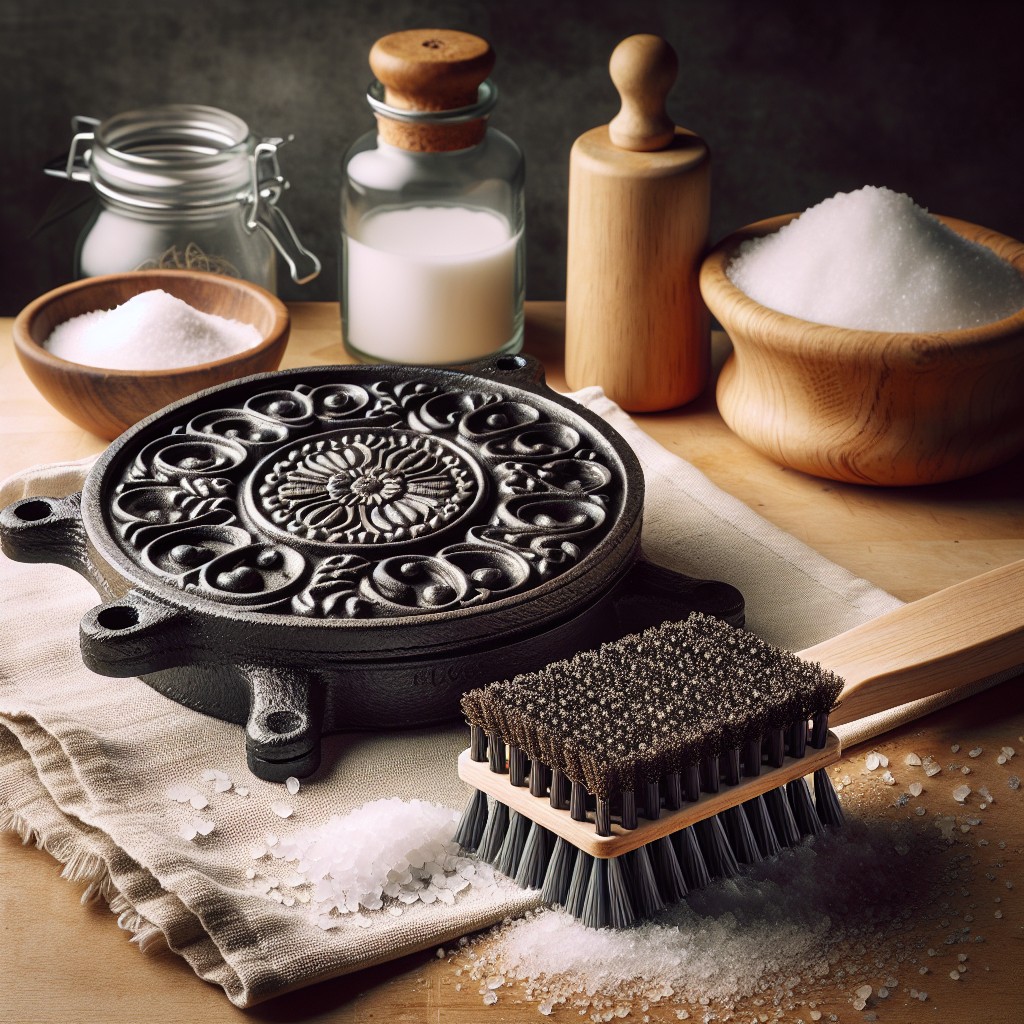
Preserving cast iron cookware requires specific yet straightforward care steps. Start by allowing the press to cool down entirely. Once cooled, use a soft-bristled brush or non-abrasive pad to remove leftover crumbs. Warm water can aid in this. Should stubborn bits remain, feel free to use a bit of mild soap, though remember, overuse can strip the seasoning.
After tidying, dry with a towel straight away to prevent rusting. Cast iron’s propensity for rust makes immediate drying crucial. For an extra layer of protection, apply a light coating of vegetable oil to the press’s surface. This oil treatment helps maintain the seasoning and keeps iron rust at bay.
Lastly, to store, avoid enclosed areas that can trap moisture. Places with ample ventilation are ideal, and a paper towel between the press plates can absorb any residual dampness. Remember, consistent maintenance keeps the press in top shape longer, ensuring a lasting culinary companion.
How to Season Your Cast Iron Pizzelle Press

Seasoning creates a protective layer to prevent rust and enhance the non-stick properties of your press – almost like creating a custom non-stick surface. There are certain materials you will need for this process, which are: a cloth or paper towel, shortening or vegetable oil, and an oven.
1. First, ensure your press is clean and dry. Any traces of food or moisture can interfere with the seasoning process.
2. Take a cloth or paper towel and apply a thin, even coating of shortening or vegetable oil to all surfaces of the press, including the handles.
3. Preheat your oven to approximately 375°F (190°C). Once the oven is hot enough, place the oiled press inside. Make sure to put it upside down to allow for any excess oil to drip out.
4. Let it bake for about an hour. During this time, the heat opens up the pores of the iron and allows the oil to soak in.
5. After an hour, turn off the oven and let the press cool inside. This allows the oil to harden and create that crucial protective layer.
With this done, your press is prepared. Remember not to use dish soap on the press after you’ve seasoned it – simply wipe clean with a dry or slightly damp cloth to maintain the seasoning. With proper care, this seasoning can last for several months, even years.
Where to Purchase a Cast Iron Pizzelle Press
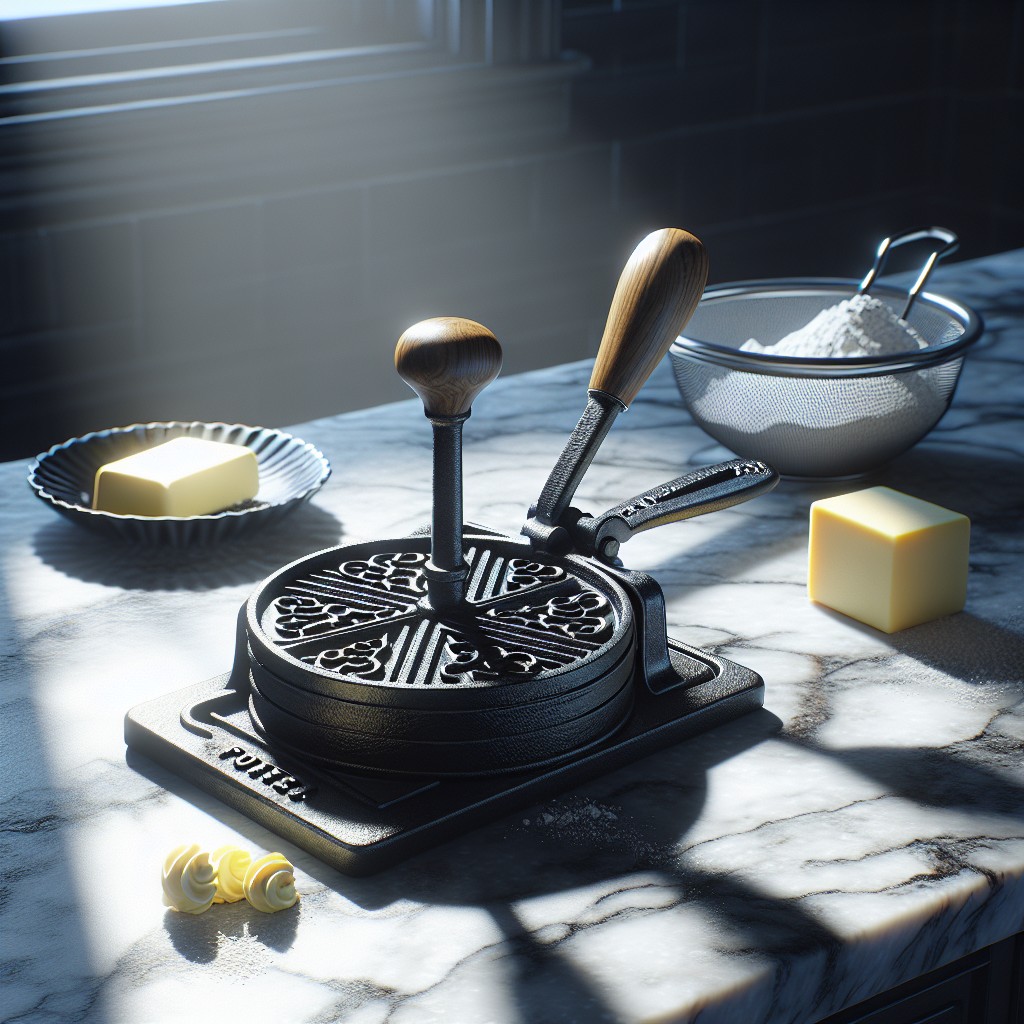
Consider a variety of sources when looking to invest in a cast iron pizzelle press. Trusted online retailers such as Amazon and eBay often have a wide selection, including new and used options, catering to different budgets. Specialty kitchenware stores like Williams Sonoma and Sur La Table are also worth a visit. They carry high-quality cooking equipment and their knowledgeable staff can offer valuable advice.
For budget-friendly choices, garage sales, thrift stores, or estate sales may yield some surprising finds. Kitchenware can be amongst the most popular items, and these venues often offer gently-used or even vintage cast iron pizzelle presses.
Lastly, don’t overlook artisan sites like Etsy where homemade cast iron press designs can give a unique, rustic flair to your kitchen tools. Remember to always authenticate the product and seller to ensure a safe purchase.
Each source offers different advantages so consider your needs, budget, and preferences before making your decision. Remember, it’s not just about buying a tool, it’s about choosing an investment piece that will contribute to many culinary creations for years to come.
Health Benefits of Using a Cast Iron Pizzelle Press

Utilizing a cast iron pizzelle press comes with some distinctive health perks. First, cast iron cookware is known to fortify food with iron, a vital nutrient, especially beneficial to those prone to anemia. As you cook in it, some iron from the press leaches into the food, making it a natural iron booster.
Secondly, a non-stick coating is unnecessary for cast iron. This fact eliminates the potential risk of overheating synthetic polymers found in many non-stick surfaces, reducing exposure to harmful compounds.
Moreover, cast iron provides excellent heat retention, ensuring even heating for perfectly cooked pizzelle. This lessens the need for excessive cooking oils, contributing to a lower-fat, healthier treat.
Lastly, cast iron is durable and long-lasting when taken care of properly, making it a sustainable choice, reducing waste and needless replacements. A well-maintained cast iron pizzelle press can serve you for generations, promoting healthy cooking methods for years to come.
Cast Iron Pizzelle Press: New Home Gift Idea

Featuring a balance of old-world charm and functionality, these cooking devices make a delightful housewarming surprise. An excellent conversation starter, a cast iron pizzelle press leaves a lasting impression, bound to remind guests of Italy’s rich culinary tradition. It’s not only an attractive kitchen accessory but proves its worth by creating delicious, thin waffle-like cookies.
Notably, this gift is extremely practical. Suitable for traditional stovetops and open flame cooking, these presses provide flexibility in preparation sites.
It’s honestly a thoughtful way to welcome someone to their new home by encouraging culinary exploration and inviting them to learn about Italian cuisine. Friends and family can gather, create memories and enjoy these versatile treats – sweet or savory, used in appetizers, desserts, or just paired with tea.
For those conscious about health, remind them that cooking on cast iron can increase iron content in foods. That’s another tick in the benefits column!
Lastly, the longevity and durability of cast iron, if cared for properly, means your gift could potentially last for generations, becoming a cherished heirloom. Now, that’s a gift that keeps on giving!
Step-by-Step Guide: Using Your Cast Iron Pizzelle Press

First off, assemble the pizzelle press and preheat it. It’s crucial to note that cast iron retains heat well; a medium-low setting should suffice.
While your press heats up, whip up the dough based on your chosen recipe. It’s generally a mix infused with vanilla, almond or anise, but the flavor choice is yours.
Now comes the fun part, dolloping your dough onto the press. A heaping tablespoon or small ice cream scoop ensures just enough for the perfect thin, crispy pizzelle. Once you’ve got your dough in place, close the press firmly to shape the classic designs on your cookies.
Timings may vary, only 45-60 seconds are needed until golden brown. Adjust based on your preference for soft or crispy pizzelles.
Remove carefully with a nonmetal spatula to prevent scratching the cast iron, lay flat to cool, and continue the process until you’ve baked all your dough!
Remember to handle the press with mitts; cast iron stays hot for a while post cooking. Now that wasn’t too hard, was it? In no time, you’ll be a pro at using your cast iron pizzelle press. Happy pizzelle pressing!
Traditional Italian Recipes for Your Pizzelle Press

In Italy, Pizzelles serve as a beloved treat during special events and holidays. To prepare authentic Italian Pizzelles, you’ll need the following ingredients: eggs, sugar, butter or oil, flour, and anise flavoring.
Firstly, whisk together eggs and sugar until light and frothy. Then, gradually add in melted butter or oil, ensuring the blend is smooth. Combine the dry ingredients separately, then fold into the wet ingredients and add anise flavoring last.
Allow your cast iron press to heat up to medium temperature. Place a spoonful of batter in the center of the press, close, and cook until golden brown. It typically takes between 40 to 75 seconds.
While this is the standard procedure, Italian Pizzelles are versatile. Various regions in Italy use different flavorings; for example, lemon zest can be added for a citrusy touch, or replace the anise with vanilla for a simpler taste. Chocolates, nuts, and fruits can be added as well for extra flair.
Remember, the key to a perfect Pizzelle is patience; your cast iron press takes time to heat up and hold the temperature, but the resulting crispy and flavorful Pizzelles are worth every second!
Bear in mind, these traditional recipes, particularly those using anise or lemon zest, are best enjoyed fresh with a powdering of confectioners’ sugar. However, Pizzelles will keep well in an airtight container for up to two weeks.
How to Store and Care for Your Cast Iron Pizzelle Press
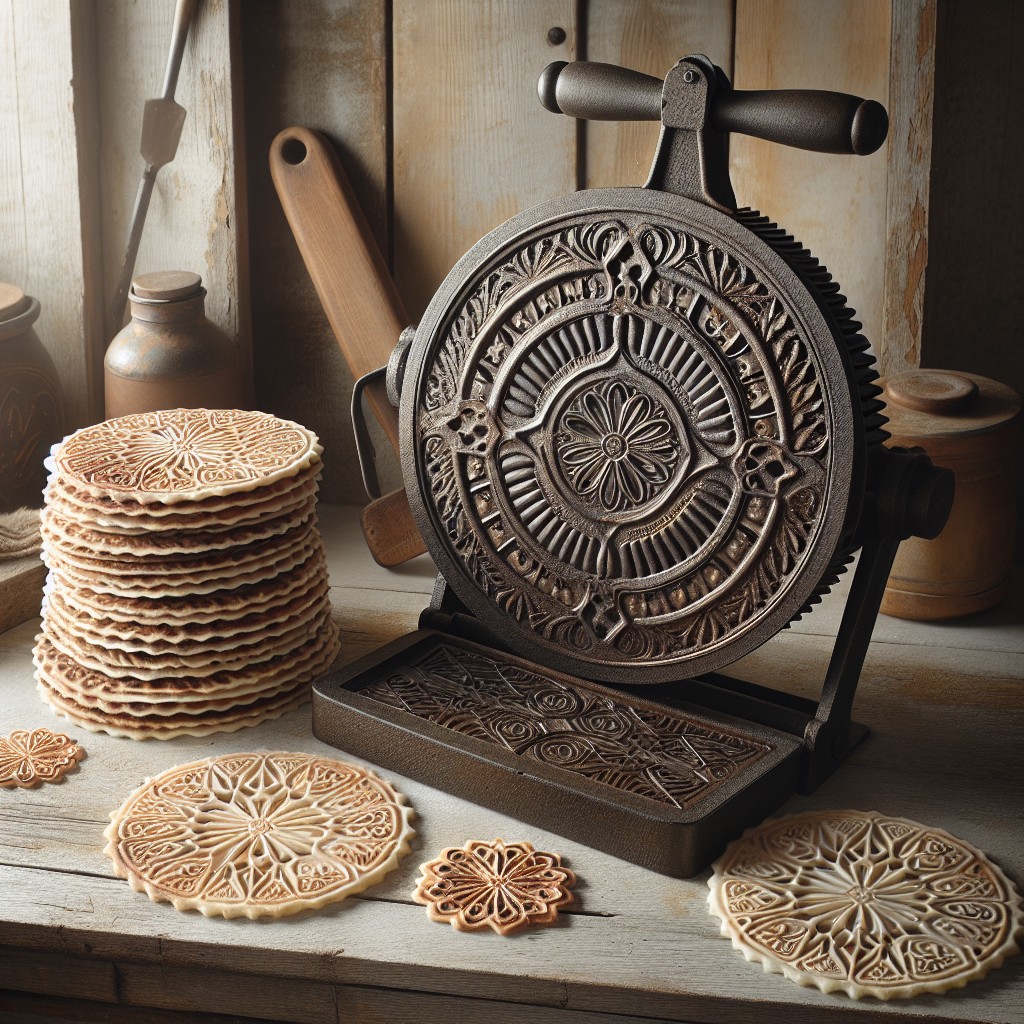
Ensuring the longevity of your tool involves proper storage and care. Firstly, dry your cast iron press thoroughly with a towel after cleaning to prevent rust. Never store it in a damp or humid place.
Secondly, avoid soaking cast iron in water, this can cause rusting and damage to the metal. Instead, clean it gently with warm water, a soft cloth, and mild, non-abrasive soap if necessary. Remember to always re-season the press after each wash to maintain its non-stick properties. A thin coating of cooking oil wiped over the surface will do the trick.
Lastly, store your press in a cool, dry place, preferably wrapped in a soft cloth to avoid scratches. Regular checks for rust spots is also advisable; if any appear, simply remove with a soft cloth or non-metallic brush and re-season.
Comparisons of Top Cast Iron Pizzelle Presses

When it comes to the leading cast iron pizzelle presses, several models stand out among the rest. The Palmer Pizzelle Maker Classic, for instance, is known for its longevity and robust design, conserving heat effectively to create perfect pizzelles every time. It, however, lacks a non-stick surface which may require some oil or seasoning to prevent sticking.
The CucinaPro Non-stick Pizzelle Maker, meanwhile, boasts cast iron plates within its design, thereby providing excellent heat retention. It comes with a non-stick surface to ensure easy removal of the pizzelle, a distinguishing factor from the Palmer model.
Furthermore, the Cuisinart WM-PZ10 Pizzelle Press features multiple temperature settings for varying degrees of crispness. The cast iron core of this press ensures even heating, and the non-stick surface ensures quick cleanup.
Lastly, the VillaWare V3600-NS Prego Pizzelle Baker offers extra-thick baking plates for heat stability, with a steam guard to protect hands. The potential drawback is its larger size which can limit the countertop or storage space.
When comparing these models, factors to consider include heat retention, non-stick feature, safety features, and overall durability. Hopefully, these insights help you make a more informed buying decision. Each model has its own strengths and minor weaknesses, but all are top performers in the world of pizzelle making.
Recipe Adaptations for a Cast Iron Pizzelle Press

Creating edible artistry with a cast iron pizzelle press broadens the spectrum of recipe possibilities. Traditional Italian pizzelles typically use simple ingredients such as eggs, sugar, flour, and anise or vanilla. However, experimentations beyond these classics unlock a world of unique flavors and textures.
1. Alternative Flours: Gluten-free flours like almond or coconut provide delicious variations while catering to dietary restrictions.
2. Sugar Substitutes: Sweeteners such as honey, maple syrup, or stevia offer a range of different taste profiles.
3. Adding Extras: Invigorate your pizzelles with nuts, dried berries, or zests for an extra punch.
4. Different Liquids: Using buttermilk, almond milk, or a dark stout creates flavorful and texture changes.
5. Spices and Extracts: Beyond vanilla and anise, consider using almond extract, nutmeg, cinnamon, or cardamom to spice things up! A touch of cocoa powder can turn your pizzelles into a chocolate delight.
Remember, when adapting recipes with different ingredients, monitor the consistency of your pizzelle batter. It should be similar to cake batter; not too stiff and not too runny. Happy baking!
Making Gluten-Free Pizzelles With Your Cast Iron Press

Embracing a gluten-free diet doesn’t mean you have to bid farewell to these delightful Italian treats. Thankfully, there’s a variety of gluten-free flours available on the market which make an excellent substitution for traditional wheat flour.
1. Replacing the Flour: Almond and coconut flours are excellent gluten-free options that also add a tasty twist to your pizzelles.
2. Binding Ingredients: Xanthan gum can be added to gluten-free flours to give your pizzelle mixture the right consistency.
3. Checking Brand Labels: Always ensure that your ingredients, including flavorings and baking powder, are labelled gluten-free.
4. Recipe Adjustments: Experiment with your dough, as gluten-free mixes might require slightly more liquid added to get the right consistency.
5. Taste Testing: Remember, gluten-free flours may alter the taste and texture of your pizzelles, so try a few different combinations to find your favourite recipe.
Armed with these tips, there won’t be any challenge stopping you from enjoying delicious gluten-free pizzelles from your cast iron press. Enjoy experimenting with different flavors and textures to create indulgent treats, that not only cater to dietary restrictions, but also possess their own unique charm!
Breakfast Ideas Using a Cast Iron Pizzelle Press

You may not immediately associate pizzelle with breakfast, but the versatile press opens up a world of exciting morning meal possibilities. Consider these delicious and quick ideas for a remarkable start to your day.
1. Pizzelle Pancakes: These delicacies are super easy. Simply replace the traditional recipe with your favorite pancake batter. Once cooked, serve with syrup, fruits, or a sprinkle of powdered sugar.
2. Scrambled Egg Pizzelle Tacos: Prepare a light pizzelle and fold it around a filling of scrambled eggs, avocado, and a sprinkling of cheese for a satisfying handheld breakfast.
3. Pizzelle French Toast: Dip your prepared pizzelle in a mix of beaten egg and milk, then pan-fry until golden for a twist on a classic breakfast favorite.
4. Granola Pizzelle Parfait: Layer a crunchy pizzelle, Greek yogurt, fruits, and granola for a delightful breakfast parfait.
5. Pizzelle Breakfast Sandwich: A savory pizzelle can be used as a sandwich bread substitute. Think ham, egg, and cheese squeezed between two crispy pizzelle.
Remember, a pizzelle press is a diverse tool. Use these ideas as a springboard for inventing your own breakfast creations!
Creative Desserts to Make With a Pizzelle Press
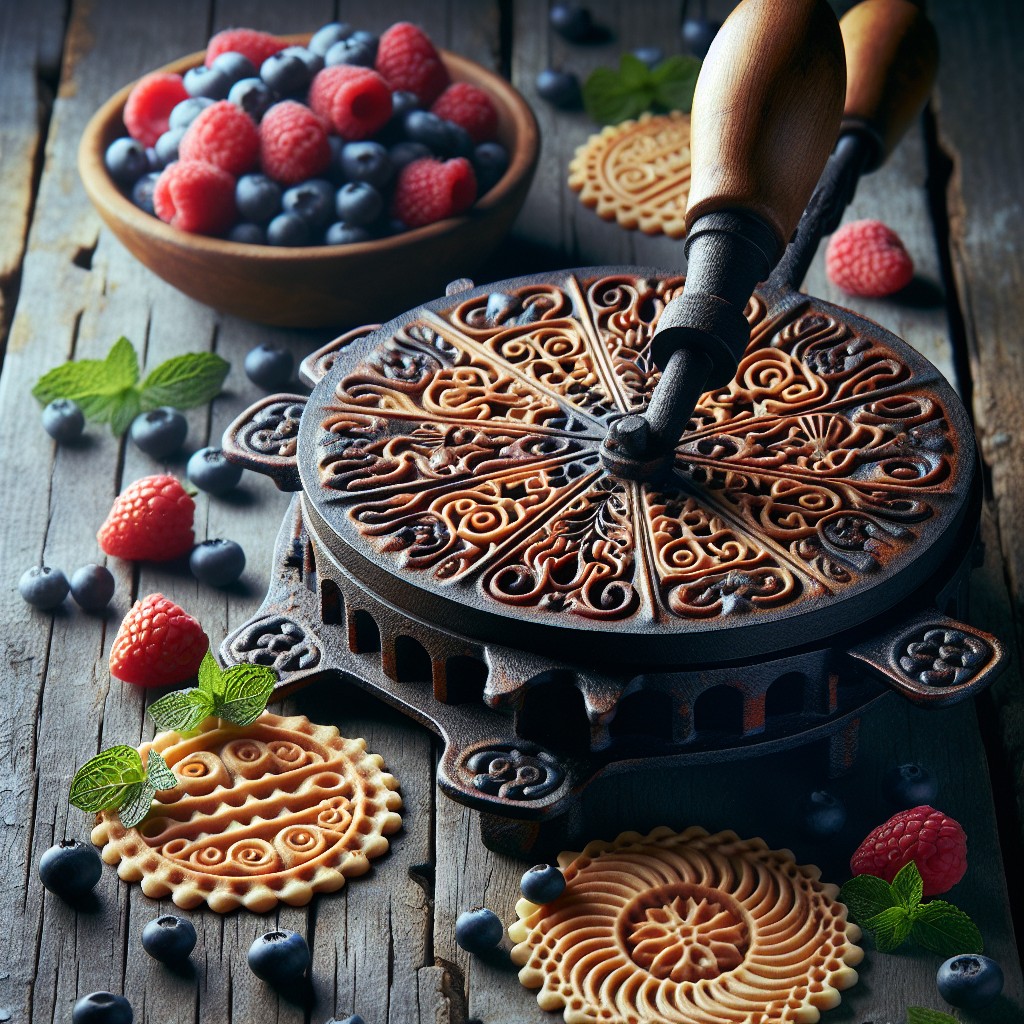
Exploring beyond traditional recipes can spark culinary creativity, especially when using a pizzelle press. Unique dessert ideas can add a fun twist to any gathering or family dinner.
For instance:
- Mini Ice Cream Sandwiches: Make standard pizzelles, let cool and fill with favorite ice cream flavors.
- Pizzelle Fruit Tart: Line a tart pan with fresh pizzelles and fill it with mascarpone cheese and fresh fruit.
- Cannoli: While a pizzelle is still warm, roll it into a cannoli shape, let cool, then fill with classic cannoli filling.
- Chocolate Drizzled Pizzelles: Drizzle your cookies with white or dark chocolate for a sweet touch.
- Pizzelle Tiramisu: Use pizzelles instead of ladyfingers for a twist to the classic Italian dessert.
- Pizzelle S’mores: Use pizzelles instead of graham crackers for a crispy, whimsical take on the campfire favorite.
Remember, the versatility of the pizzelle press ensures that any dessert creation is possible, from simple to sophisticated.
Savory Pizzelles: Using Your Cast Iron Press for Non-Traditional Recipes

While pizzelles are traditionally sweet, they can be reimagined as an innovative savory treat. With the right ingredients, your cast iron press can churn out unique appetizers and snacks that will impress your guests.
Here are some concepts:
- 1. Cheese Infusion: Mix in a sharp cheese like asiago or parmesan to give the pizzelle a surprising savory twist.
- 2. Herb Experimentation: Incorporating flavorful herbs like rosemary, thyme, or basil can create a tasty and aromatic pizzelle.
- 3. Garlic Twist: Adding minced garlic to the batter will not only contribute a delicious flavor but an aroma that fills your kitchen.
- 4. Spice It Up: For those who enjoy a bit of heat, spices such as smoked paprika or cracked black pepper could be a game-changer.
- 5. Sea Salt Sprinkle: Lightly dust your pizzelles with sea salt immediately after pressing for a subtle yet savory finish.
Remember, creating savory pizzelles is all about experimentation and playing with flavors you love. Don’t be afraid to get creative and break the sweet tradition!




